As I mentioned in Looper Prep #3, most of my positive expectations for Looper stem from my appreciation for Brick and The Brothers Bloom, Rian Johnson‘s first two features. I’m not interested in reviewing those films, but I do want to dig into their depths some, as a way of getting ready for Looper.
Brick
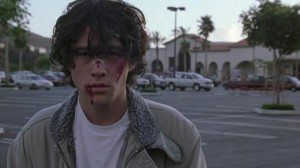 There aren’t many directors who can pull off a first feature like Brick. On the one hand, it’s a classic hardboiled detective tale. On the other hand, it’s not at all.
There aren’t many directors who can pull off a first feature like Brick. On the one hand, it’s a classic hardboiled detective tale. On the other hand, it’s not at all.
Even if Brick was just another neo noir—and these get released every few months—it would be an accomplishment of construction. It’s no easy feat to write a detective story that comes together at the end and which avoids spilling the beans in the first reel.
On top of this, it’s high school. Why, you wonder? Because setting it in high school highlights just how bizarre the hardboiled genre is. Were there ever men like Philip Marlowe out there, even in the 1940s, wearing fedoras and spitting one-liners like sunflower seeds? We might like to believe so, but you find me someone who knew a fella like that and I’ll buy you lunch.
By setting Brick at San Clemente High School, Johnson slaps us around with our gullibility. Is it any more preposterous that Brendan Frye is playing the angles with Assistant Vice Principal Trueman (Richard Roundtree!) then it is that Sam Spade is chasing the stuff that dreams are made of?
 In Brick, the Pin drives around in a van with a table lamp and couch conducting drug deals wearing a cape. Nuts. And yet we have no trouble believing what we see. (Cue the Supreme Being‘s ire: he hates both of Johnson’s features. I think “loathe” was the word he used.)
In Brick, the Pin drives around in a van with a table lamp and couch conducting drug deals wearing a cape. Nuts. And yet we have no trouble believing what we see. (Cue the Supreme Being‘s ire: he hates both of Johnson’s features. I think “loathe” was the word he used.)
To take something not right and make it sidle up to you so slow and sweet you get suckered, that’s an achievement of writing and directing. Rian Johnson is, essentially, telling a tale true—like his characters do in The Brothers Bloom.
There are a few things I want to point out, just to help you catch the color of Brick if your brain hasn’t hopped into gear yet.
- When we see what’s left of Emily in the tunnel’s maw, grok the waves; of water, of her blonde hair, in her blue bracelets. These waves return later, on the beach with the Pin, when actor Luke Haas steps outside of the story to talk about Tolkien. Remember why the Pin likes Tolkien? Because the author describes things in way that make them seem real. Waves become a lyrical motif that travels like, well, waves. Emily’s dead, and from her death, there is a flow that can’t be turned, no mater how bullheaded Brendan gets.
- Behind Coffee and Pie Oh My, when Brendan slaps the smoke out of Dode’s mouth, it’s almost identical to a shot in Johnson’s student work, Evil Demon Golfball from Hell. Also, when Tugger lets Brendan have it in the mall parking lot, Rian uses the same sort of jangling handheld push in he practiced in that same early work.
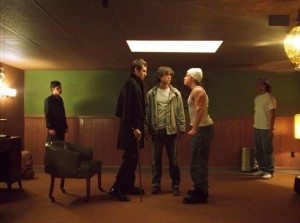 In the Pin’s basement, Brendan sows doubt in the Pin’s mind as to Tugger’s loyalty. This scene parallels a scene in Miller’s Crossing, in which Tom turns Caspar against Eddie the Dane. If you haven’t watched that film, you’re missing out. Do as Caspar says, and always put one in the brain.
In the Pin’s basement, Brendan sows doubt in the Pin’s mind as to Tugger’s loyalty. This scene parallels a scene in Miller’s Crossing, in which Tom turns Caspar against Eddie the Dane. If you haven’t watched that film, you’re missing out. Do as Caspar says, and always put one in the brain.
Brothers Bloom
It seems to me that in the end, the perfect con is where each one involved gets just the thing they wanted.
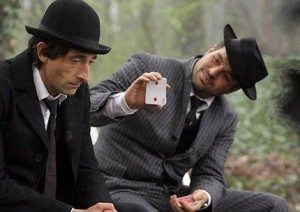 There are so many levels to Bloom, it’s like Nakatomi Plaza. Who, do you suppose, is conning whom? And when do those cons begin or end?
There are so many levels to Bloom, it’s like Nakatomi Plaza. Who, do you suppose, is conning whom? And when do those cons begin or end?
Having watched Bloom thrice and read the script, I’ve got my ideas. But jamming your hands in there and pulling on the strings is the fun part. Far be it from me to dissect the thing like some poor 10th grade biology project. I will, however, call out a few bits and bobs that speak to the heart of the picture for me.
- First off, Ricky Jay. If you don’t recognize the narrator of the opening segment, this is one of the world’s greatest slight-of-hand experts. You may recognize him from his work with David Mamet or in Paul Thomas Anderson films.
- Stephen repeatedly performs a ‘card trick’ in the film, in which he randomly cuts the deck hoping to pull the same card the mark is thinking of. If he gets it, “then it’ll be the best card trick in the world.” For those wondering how much of film is part of Stephen’s plan, think of a card.
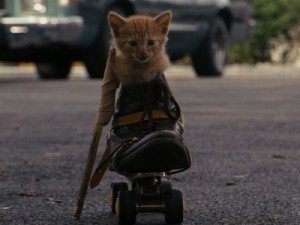 On the other hand, when Stephen first tells Bloom of the whole (initial) Penelope con, he says, “and so that’s how it ends, in Mexico, a burst of violence then a moment of truth on the beach.” And lo, even though it surprises Bloom to actually come to blows with his brother, that is indeed how the con ends. (If it ends.) Bloom expected the burst of violence (the gunshot), but not a moment of truth.
On the other hand, when Stephen first tells Bloom of the whole (initial) Penelope con, he says, “and so that’s how it ends, in Mexico, a burst of violence then a moment of truth on the beach.” And lo, even though it surprises Bloom to actually come to blows with his brother, that is indeed how the con ends. (If it ends.) Bloom expected the burst of violence (the gunshot), but not a moment of truth.- For a meticulous planner, Stephen gives Penelope plenty of clues that she’s being conned—the name of the ship, calling Bang Bang ‘Yeungling’—even though he knows his mark is a repository of random facts and talents. Why would he do this, unless he knows she knows, and is in fact counting on her conning them?
- Think, for a moment, about ‘following the light’ as a motif in the film. Right? Right.
- In the film, we see Stephen’s cons laid out as flowcharts with numbered boxes. We see that #12 is the Curator’s Tale and that #14 is Castle Break In. In between those two pieces—both essential for the con—what happens? The Diamond Dog appears. If that’s not #13, what is? And if it is #13, are you still wondering what’s part of Stephen’s plan?
- On the other hand, how does the brick of explosive end up in the tower? Penelope put it in the correct bag, at least as far as Stephen was concerned. So did Bang Bang do that on purpose? (Also, it’s no accident what that ‘brick’ of explosives resembles.) Who, I ask you, is Bang Bang, really? Could she be, perhaps, a plant? And if so, who’s? I’ll give you one answer that works for me: I think Bang Bang works for the Diamond Dog (and Stephen knows it).
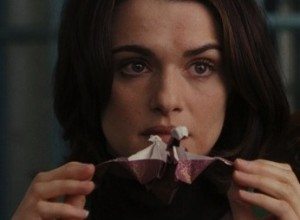 Speaking of complex cons; let’s look at Penelope. She can juggle chainsaws, fold origami cranes, and build a ship in a bottle. What can’t she do? Drive. A car. Up her own driveway. Bloom mentions that the best way to sucker a mark is to have them put you in the hospital. How does Bloom meet Penelope?
Speaking of complex cons; let’s look at Penelope. She can juggle chainsaws, fold origami cranes, and build a ship in a bottle. What can’t she do? Drive. A car. Up her own driveway. Bloom mentions that the best way to sucker a mark is to have them put you in the hospital. How does Bloom meet Penelope?- When Bloom has his apple-stealing epiphany, Stephen bails him out of jail. Is this, or is this not, everything going according to plan?
- The entire film is a story that draws us in: which is what Penelope and Stephen spend their lives trying to do; tell stories so that they become real. It’s like a pin-hole camera made out of a melon: “It’s a lie that tells the truth.”
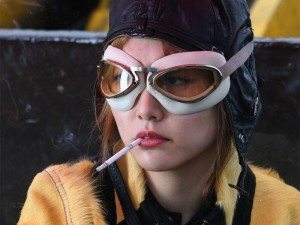 I think that’s more than enough. Again; you have bits of the Brothers Bloom you want to banter about? I’m your man.
I think that’s more than enough. Again; you have bits of the Brothers Bloom you want to banter about? I’m your man.
Looper is almost here and I’m feeling extra-ready. Even so, we’ll try to get to another Looper Prep post in the next week. What could it be about? Assassinations gone wrong? Joseph Gordon-Levitt’s rise from sit-com beginnings? Films with one-word titles that opened in September?
Only time will tell.

I seriously think you’ve left this planet and turned into another person reading your take on The Brothers Bloom. I am baffled, flummoxed, and there is a pain in me gulliver.
At least Looper looks like an attempt to be about actual people. We shall see.
There is that Venn diagram segment of films about which we disagree vehemently. I suppose Bloom and Brick fall in there.
Do you really think Looper will be more about ‘actual people’ than these two? I doubt it. Rian Johnson writes about worlds that are on the edges of reality. Perhaps that’s the difference between us: I enjoy those types of stories (in his case, at least) and they irk you to no end (in his case, at least).
Oh well. Perhaps we shouldn’t see Looper together…
hm, yeah, you’d better stick with the venn diagram argument.
saying i don’t like films that exist in a different reality would be a mighty strange thing to say. let me show you this script about two guys who dig inside the moon and…
ah. that’s not what i meant but i see it’s more or less what i wrote. oops.
that’s it! you’re off the blog! into the dungeons with you!
a dungeon in reality or one that’s on the edge of reality? will woody allen be there?
Just read this again, I love both these films. I really like the stylisation of Brick but what always gets me about the film is not specific themes, but how gripping it is, there is a sense of urgency and empathy I feel with Brendan and his desperation to solve the puzzle always pulls me in.
Brothers Bloom I always saw as a kind of fairytale. I always saw the film as being about the act of writing
When I originally watched the thing I picked up on the most was Stephen representing a writer (and a sort of God) who has control of his characters and is trying to tell a perfect story and make his audience and his characters happy but in the process realises he has to sacrifice himself for that perfection. Before that in all his cons, he was writing for himself and his own satifsfaction and then selling the idea to Bloom.
.
That’s an interesting read; for god to perfect creation, he must write himself out of the script…
Who’s excited for Looper 2???